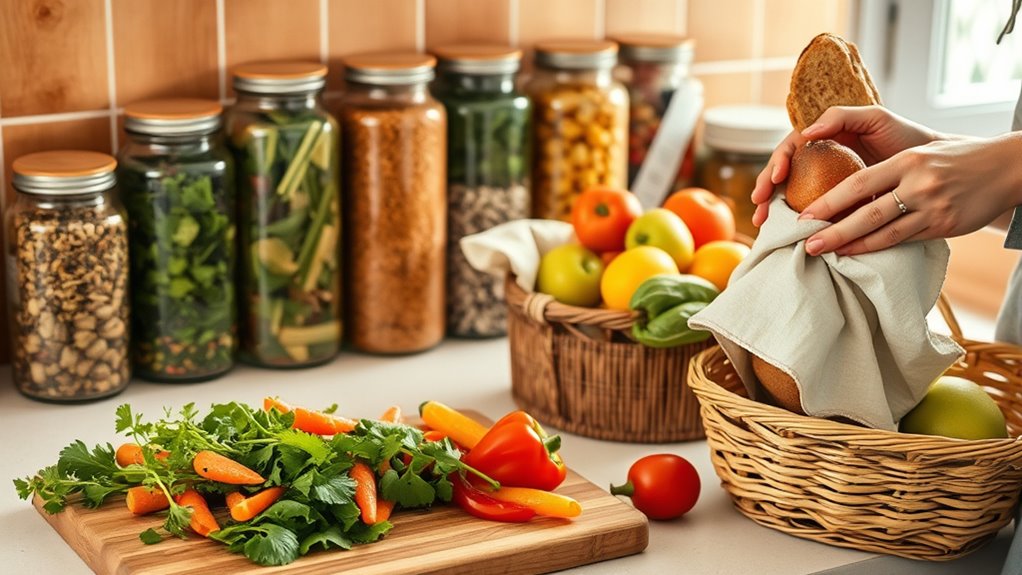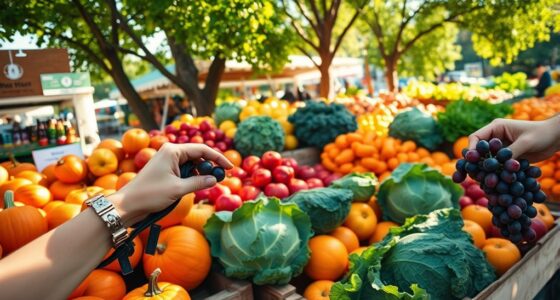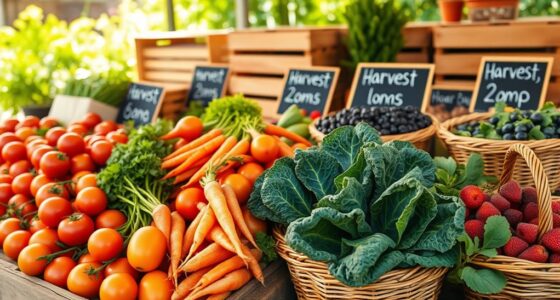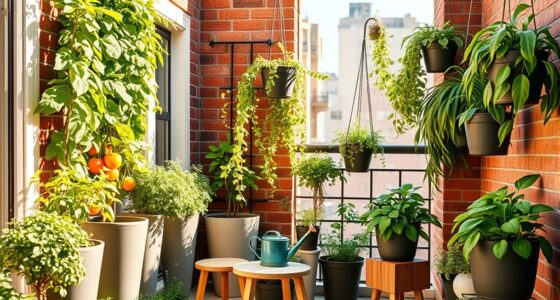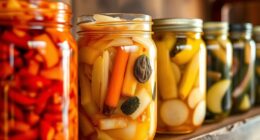To reduce food waste at home, plan your meals weekly to avoid impulse buying and store ingredients properly to extend their freshness. Make a shopping list based on your meal plan, buying only what you need, and use versatile ingredients across different dishes. Compost food scraps like vegetable peels and coffee grounds instead of tossing them away. These simple steps help save money, lessen waste, and support eco-friendly habits—more practical tips await if you continue exploring.
Key Takeaways
- Plan weekly meals and create shopping lists to buy only necessary ingredients, reducing impulse purchases and leftovers.
- Store food properly to extend freshness and use versatile ingredients across multiple recipes to minimize waste.
- Use indoor or outdoor composting methods for food scraps like vegetable peels and coffee grounds to enrich soil sustainably.
- Avoid discarding food prematurely by managing portion sizes and utilizing leftovers creatively.
- Regularly monitor and adjust your shopping and storage habits to identify waste patterns and improve sustainability.
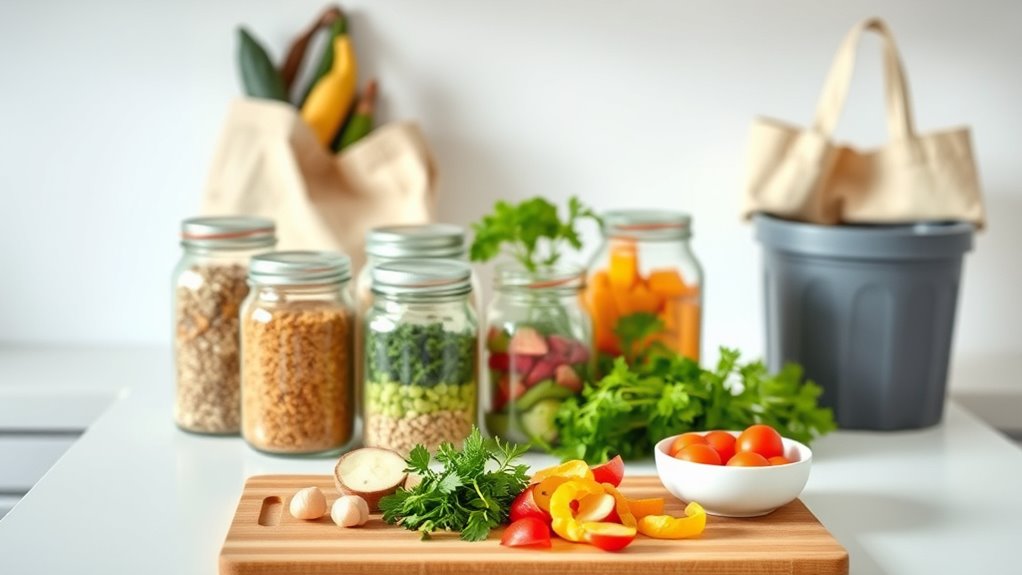
Have you ever wondered how much food you throw away each week? It’s more than you might realize, and it’s costing you money, resources, and contributing to environmental issues. One effective way to cut down on waste is by focusing on meal planning. Instead of buying ingredients impulsively or making last-minute trips to the store, take some time to plan your weekly meals. This helps you buy only what you need, reducing the chances of leftovers that go bad. Create a shopping list based on your meal plan, and stick to it when you’re at the store. Not only does this save money, but it also minimizes the chances of purchasing unnecessary items that end up in the trash. When you plan your meals carefully, you can also incorporate versatile ingredients that can be used in multiple dishes, decreasing the likelihood of spoilage.
Another essential aspect of reducing food waste is understanding composting methods. Composting allows you to turn food scraps into nutrient-rich soil instead of throwing them away. You can start small by composting kitchen scraps like vegetable peels, coffee grounds, eggshells, and fruit scraps. These organic materials break down naturally and can be added to your garden or a compost pile if you have outdoor space. If you don’t have a backyard, there are indoor composting options available, such as countertop compost bins that contain odors and make it easy to manage scraps. By composting, you reduce the amount of waste sent to landfills and create a valuable resource for your garden or houseplants. It’s a simple, eco-friendly method that makes you more mindful of what you discard and encourages a circular approach to food consumption. Additionally, understanding precious metals investment can inspire you to think about sustainable practices and resource conservation.
Combining meal planning with effective composting methods can considerably lower your household’s food waste. When you plan your meals, you can buy only what you’ll use, and when you inevitably have leftovers or food scraps, you can compost them instead of tossing them in the trash. This not only reduces waste but also enriches your soil, closing the loop in your food cycle. Plus, becoming more conscious of what you throw away helps you identify patterns in your consumption, encouraging smarter shopping and better storage practices. Over time, these small adjustments can add up, making a meaningful impact on reducing your overall food waste, saving you money, and helping the environment.
Frequently Asked Questions
How Can I Compost Food Scraps Effectively at Home?
You can compost food scraps effectively at home by starting worm composting, which speeds up decomposition and reduces odors. Use a dedicated compost bin and maintain it regularly by turning the contents and adding browns like leaves or paper to balance moisture. Keep the bin moist but not soggy, and monitor for pests. Proper compost bin maintenance guarantees healthy worms and nutrient-rich compost, helping you reduce waste efficiently.
What Are Creative Ways to Use Leftover Ingredients?
Why toss those leftover veggies when you can turn them into creative recipe ideas? Use leftover ingredient hacks like blending overripe bananas into smoothies or stuffing stale bread with cheese for crispy croutons. Turn wilted greens into pesto or leftover rice into fried rice masterpieces. You’ll save money, reduce waste, and impress everyone with your culinary ingenuity. Who knew leftovers could be the secret to your next delicious, waste-free meal?
How Do I Manage Portion Sizes to Prevent Waste?
You can manage portion sizes by practicing proper meal portioning and adjusting food serving sizes to suit your needs. Use smaller plates or bowls to naturally limit portions, and serve yourself smaller amounts initially, saving extra for seconds if still hungry. Pay attention to your hunger cues, and plan meals ahead to prevent overeating. These strategies help reduce waste by ensuring you only prepare and serve what you’ll actually eat.
What Tools Can Help Track My Food Inventory?
Think of your kitchen as a bustling warehouse; smart refrigerators and inventory apps become your trusty inventory managers. These tools help you track food items, expiration dates, and quantities in real-time. For example, a smart fridge can alert you when milk is nearing expiry, preventing waste. By embracing these tools, you gain control, reduce waste, and save money—making your kitchen more efficient and eco-friendly.
How Can Meal Planning Reduce Overall Food Waste?
Meal planning helps you reduce food waste by guiding your shopping list and meal prep. When you plan your meals in advance, you buy only what you need, minimizing impulse purchases and excess leftovers. By creating a detailed shopping list, you avoid unnecessary items that might go to waste. Additionally, meal prep allows you to use ingredients efficiently, ensuring nothing gets spoiled and maximizing your food’s longevity.
Conclusion
By adopting these simple tips, you’ll cut down on food waste and keep your home eco-friendly. Think of yourself as a modern-day Robin Hood, saving resources instead of stealing from the rich. Just like Marie Antoinette’s famous, “Let them eat cake,” don’t let good food go to waste—cherish it. With a little effort, you’ll be living sustainably in a world where even your pantry feels like a well-stocked, eco-friendly spaceship.
Ilana has been a vegan for over 10 years. She originally made the switch for health reasons, but soon found herself becoming more and more passionate about the ethical and environmental implications of a vegan lifestyle. Ilana is the author of The Graceful Kitchen, a blog all about veganism. She loves to cook up delicious and nutritious vegan meals, and share her recipes with others who are interested in leading a cruelty-free life. Ilana is also a strong advocate for using whole foods as the foundation of a healthy diet, and believes that going vegan is one of the best ways to achieve this.
